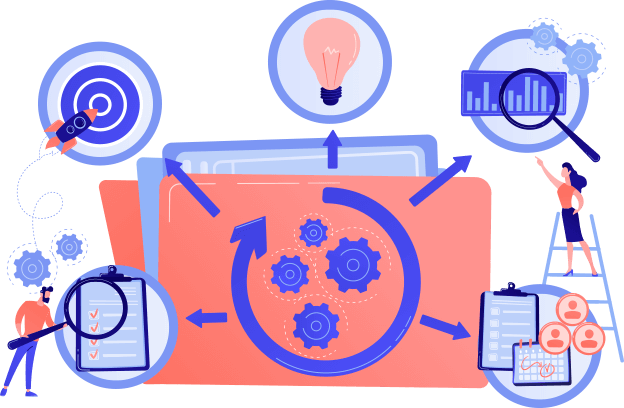We all know how hard it is to run an engaging meeting. To many of us, this seems like a strenuous task. Where do you even start?
Do you have to behave differently? And what about your colleagues that are on the shyer side—how do you motivate them to participate?
Fortunately, we have an answer. In this article, we’ll take a closer look at the 15 things managers and facilitators should do, in order to host captivating meetings and encourage their colleagues to make meaningful contributions.
Let’s dive right in, shall we?
Why you should host engaging online meetings
Meetings are a crucial part of every organization. It allows people within a company to gather and exchange valuable ideas as well as make informed decisions that will help a business grow.
However, in order for meetings to deliver value to both employees and the organization, they have to be engaging—people need to care about the subject matter and be motivated to provide their input.
On the surface, coming up with a strategy to boost meeting engagement may seem like unrewarding investment that will distract stakeholders from “real problems.” In reality, there’s a host of reasons why companies should look into it:
- It builds stronger relationships – when people actively participate in meetings, they become invested in the company’s success as well as their own professional growth;
- It facilitates and improves decision-making – shorter, more efficient meetings don’t last enough to become dull. The more involved the participants of a meeting are in the conversation, the quicker clever solutions arise;
- It helps companies think outside the box – when there are no bystanders in you meetings, there is greater diversity of opinion, which opens your business up to more innovative ideas;
- It acts as a medium for constant improvement – when engaging meetings become a part of the company culture, everybody wins. The organization reaps the benefits of clever and innovative decisions, while employees can learn from one another and grow professionally;

1. Prepare an agenda for your meeting
To ensure that people have something to say in a meeting, it’s essential to at least tell them what the meeting is about. Even better, provide them with a clear outline that will allow them to navigate it more efficiently. Not understanding the scope and structure of the meeting is a recipe for discomfort and awkwardness—and that’s exactly what we want to avoid.
Always make sure to attach the meeting agenda to your invitation. This small detail will have a massive impact on the team’s productivity by allowing them to structure their thoughts and provide their input on the subject matter.
If you’re looking to earn some bonus points and help people be more proactive by having an agenda, there are two things you should also look into:
1. Stick to the plan – sending out an agenda and not following the timetable will just defeat the purpose helping people participate;
2. Ask for feedback – allow people to weigh in on how well the meeting was structured and whether they’d like to suggest changes to further meetings;
There are so many questions you can ask to learn more about the people’s preferences. Simply asking for their input will not only provide you with a roadmap for the betterment of your next meetings, but also make them feel heard and included. Here are a few examples:
- Did you find our last meeting productive?
- What part of the meeting do you think was most valuable to you?
- What was your favorite/least favorite part?
- If you could change anything, what would it be? Why?
- What’s one thing that could increase your satisfaction with our meetings? Why?

2. Essential personnel only
Oh, just one more thing before you send out the memo for the meeting, please consider the attendees carefully. Your efforts to keep participants engaged will be rendered useless if you’ll invite people that have little to do with the issue at hand.
Yes, absolutely, this does sound self-evident, but the participant lists should be as short as possible. Every single person that has but a remote connection to the topic at hand will inevitably be bored (which is the opposite of what you want).
If, for any reason, you’re wondering what the optimal number of participants in a meeting is, consider using the “two-pizza rule.” Legend has it that Jeff Bezos would follow this principle to make meetings more productive. Basically, if the number of people you’ve invited to a meeting can’t be fed with two pizzas, it’s very likely that no important decisions will be made.

3. Proactivity builds on safety
Most people will only want to be proactive in a meeting if they feel safe. Of course, this has little to do with physical safety, instead it’s a sense of acceptance—the need to know that their ideas will be taken seriously.
If you happen to be the facilitator of a meeting, consider starting by making people comfortable. Kick things off with some positive feedback on the team’s work. Even better, show some appreciation to every person in particular if there aren’t too many people attending. This should make the participants feel confident and excited about the meeting.
The power of this tactic is twofold; Firstly, it makes everyone feel accomplished and valued. Secondly, it encourages a team mentality right off the bat. Focusing on individual successes and qualities is a great way to build momentum.
4. Be mindful of the Bystander Effect
There’s a very interesting psychological study on a phenomenon called the Bystander Effect, also known as “diffusion of responsibility”. It suggests that there’s a direct correlation between the number of people in an environment and their motivation to intervene when someone has an emergency like a heart attack, for instance.
The logic behind it is pretty straightforward, the more people there are in an environment, the more diffused the responsibility is. People are prone to this effect during meetings as well.
The great part is that it’s fairly simple to overcome this effect—assign the participants tasks that they can engage in actively. This way, they won’t be inclined to be a mere bystander in the meeting you’re facilitating. Most video conferencing products have a breakout room feature; you can use it to assign small tasks to groups of people that are part of the meeting.

5. The 5-minute rule
Let’s face it—most of us have dozed off during lengthy meetings that keep going over and over the same issues. Make no mistake, people will naturally prefer watching paint dry to participating in boring meetings. Fortunately, the solution to boredom is engagement. People generally prefer to be productive, instead of attending a mind-numbing group call.
When planning your meeting agenda, try to keep it as engaging as possible. Try spending a maximum of five minutes on every issue that needs to be addressed. Otherwise, your colleagues might put on their bystander hat—and they’ll do it quicker than you expect. The worst part about it is that it’s not really that easy to bring them back, so be strategic about your meeting agenda.
6. Say my name, say my name 🎤
You’ve probably heard about the magical effects calling someone’s name has on their brain. Well, we’re here to tell you that it’s true and that you should do it more, if you want to keep people participating during meetings.
Research suggests that when people hear their names, specific parts of their brain that stimulate attention activate. People become naturally more focused and mindful as a result.
There are plenty of ways this little trick can be put to work. Instead of just asking people “any questions?,” consider calling them by their name. This will most likely make the shyer people in the crowd actually ask the question they have. Moreover, there’s a sort of chain reaction to this—people will see others participating and feel a slight push to do the same.
7. Does everyone know everyone?
Often people don’t feel comfortable sharing their opinions with people they don’t know. Therefore, when the participants of a meeting are not acquainted, this could have a harmful effect on the overall engagement.
It’s always a good idea to introduce people to each other—their names, their roles, and maybe a quick mention of their qualities. Of course, this isn’t essential if your list is extensive. But doing so whenever you can afford it will help people relax and open up.

8. Incorporate small talk
Before the Covid pandemic struck, small talk was an effortless thing. For some reason, it’s much easier to be curious about people’s experiences in their immediate presence, compared to video meetings.
If you think about it, the entire experience of a Zoom call isn’t exactly conducive to a warm exchange—a window pops up on your screen and you’re expected to go straight to the point. As a result, the whole concept of chatting with your colleagues while grabbing coffee before a meeting has vanished entirely, along with the benefits of such interactions.
Fortunately, there are a couple of quick tips that will help you bring the small talk back to your remote meetings.
- Make small talk part of your meeting agenda – by allotting time to it, you won’t be pressured to jump into work-related discussions from the get-go;
- Start every meeting with a check-in or an ice-breaker – show your willingness to engage in small talk as the person whose task it is to moderate the meeting. This should help people relax and engage effortlessly;
- Include conversation points that most people have an opinion on – whether this is tightly connected to the main topic of the meeting doesn’t matter that much. Having a conversation about things that people care about will help them express their opinion more eagerly, which will set the tone for the meeting itself;
9. The responsibility rule
Whenever people enter a social setting, they unconsciously try to determine the role they play in it. For instance, when you attend a concert (it’s been a while, hasn’t it?), you immediately establish your role at this event—you’re there to observe and enjoy. In other settings, your role is to act.
Meetings are no exception—we always try to define whether we’re there to act or observe, and we typically make this decision in the moment we’re notified about the meeting itself. Naturally, most of us will be inclined to be bystanders, but this is exactly what ends up being the cause of low engagement during meetings.
Fortunately, facilitators can solve this issue by creating a sense of shared responsibility. Have everyone prepare for the call—this doesn’t have to be a massive effort, but the time investment itself will help them stay engaged and participate eagerly.

10. Reduce your slides to the bare minimum
We’ve all been there—having to sit through a dull, hour-long presentation that bores us to tears. While they are undoubtedly necessary in situations like onboarding your team to some important changes in the company or product, there are a few recommendations a facilitator should take into account, in order to keep the audience engaged.
One crucial thing you should consider is reducing the number of slides to the bare minimum. Similarly, consider adding as little information on the slides as you can afford to. The reason is pretty simple—the less people have to read, the more you can engage with them on a personal level.
Moreover, people love storytelling—it’s a very powerful tool to keep people invested in what you have to tell them. This is going to be crucial if you’re going to be looking for meaningful feedback at the end of your presentation. Instead of just wanting to leave the room as early as they can, your colleagues will be more inclined to share their thoughts.
While adding elements of storytelling to your presentation is always a good idea, definitely consider structuring your entire meeting agenda as a coherent storyline. In narratology (yes, this is a thing), there’s this very useful concept called the “hero’s journey”. It’s sort of a template for a story where a hero goes on an adventure, faces some sort of existential crisis, and returns home transformed and a bit wiser than he or she was at the beginning of their journey. You don’t have to be as dramatic with your meeting agenda, but you get the drill.
Here’s a basic structure for a hero’s journey: Departure (the call to adventure), Initiation (a series of trials that the person confronts), the Return (the hero returns from her adventure).
11. Build a great online meeting tools stack
Making your virtual meetings more engaging also depends on the tech stack you’re using. Your organization may be using products like Slack or Zoom for communication, and project management tools to go with them, but you have the opportunity to think outside the box. There are plenty of collaborative tools like Miro that will help your team work together and engage in brainstorming synchronously.
It’s absolutely essential to take the time to explore the available solutions on the market that will help your team collaborate efficiently and remain tuned in during meetings.
12. Look into gamification
Simply put, gamification is the process of using game elements and mechanics in mundane activities with the intent to make them more engaging and even entertaining. The technique revolves around providing people with instant gratification, rewarding them for small tasks, and continuously providing them with feedback.
The reason gamification is very effective in engaging people is because of the small bursts of dopamine it triggers in our brains. As a result, the things we typically find boring or dull end up being entertaining, which helps us become more involved and productive. Furthermore, gamification is known to ease cognitive load.
So, how does one gamify a meeting? There are plenty of techniques you can choose from. For instance, you can end a meeting in a quiz and reward the participants for their attention. Another option would be tallying the number of innovative solutions your colleagues came up with during meetings in a month. This should stimulate some healthy competition among coworkers.
13. The five hippopotamus rule
The five hippopotamus Rule is a very straightforward technique that can help you motivate people to actively participate in the conversation. Now, before we go on, we need to underline that this is also a common technique used in criminal psychology during interrogations, which is called “the Pause Technique.” The main idea behind it is to remain silent after asking a question, suggesting to the interviewee that you’re expecting an answer from them.
So, back to the hippopotamus rule. The main idea behind it is not to interrogate your colleagues (really, don’t), but rather to motivate them to engage with the conversation.
How do you do it? Ask a question, and if you see no immediate engagement from your colleagues, count “one hippopotamus, two hippopotamus,” till you get to five. Another pretty important tip is to not count out loud.

14. Acknowledge contributions
While showing appreciation for your colleagues’ contributions will have a positive impact on the engagement within the meeting, it’s also more of an investment for future meetings. Being thankful about people expressing their opinion on the subject matter and, more importantly, taking their opinions seriously will create a space where people feel inclined towards participating.
Expressing appreciation for a person’s contribution is a great way to encourage more engagement—at the end of the day, they’ve made an effort to help the cause of this meeting.
Another great way to show appreciation is visible note taking—this allows you to acknowledge a person’s contribution and show that their voice is heard.
15. What do you do with engagement?
Our last tip is an extension of the previous one—it’s an attempt to take a closer look at engagement in the context of your organization. What’s the point of stimulating people to participate if they won’t see their input applied or their opinions taken into account when critical decisions are made. Using what you receive during meetings is a vital component of creating an environment where people want to participate.
The bottom line
Keeping people engaged during meetings does sound like a straightforward task, but in reality it’s far from it. The good thing is that the vast majority of steps you can make towards a more proactive crowd only require your dedication and willingness.


 Benjamin Spall, co-author of the book My Morning Routine: How Successful People Start Every Day Inspired, defines a morning routine as “
Benjamin Spall, co-author of the book My Morning Routine: How Successful People Start Every Day Inspired, defines a morning routine as “ Laura Vanderkam, the author of What The Most Successful People Do Before Breakfast,
Laura Vanderkam, the author of What The Most Successful People Do Before Breakfast, 





















































